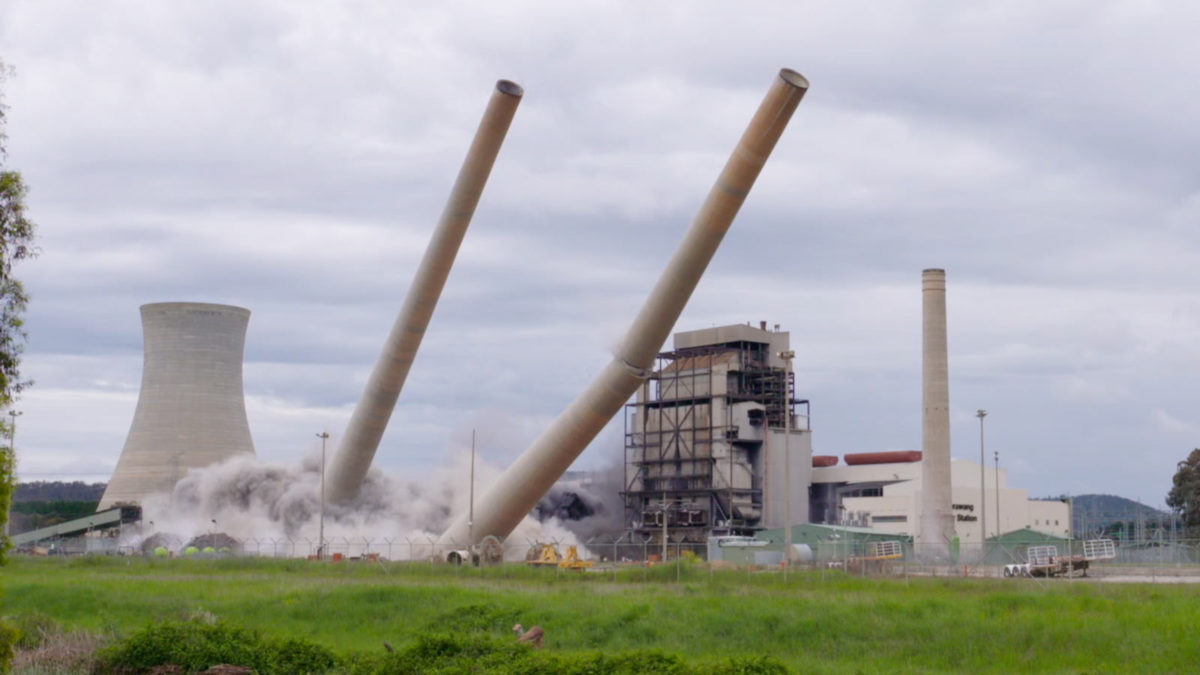The replacement of the shuttered Wallerawang coal fired power station took a spectacular step forward on Wednesday, with the retired plant’s smokestacks and boilers being demolished in a controlled explosion.
The plant’s two disused 175m-tall smokestacks were levelled, as well as the “unit 8” boiler at the site.
The Wallerawang power station’s last owner, EnergyAustralia, announced it would permanently close the power station in 2014, nearly 50 years after the plant’s ‘C’ unit first generated electricity in 1976. The power station had supplied up to around 15 per cent of New South Wales’ electricity.
The controlled demolition follows similar dismantling of the smokestacks at the former Hazelwood power station in Victoria, which had been one of the world’s most emissions-intensive coal plants, and in South Australia.
The Wallerawang site, located just outside Lithgow, is now being managed by Greenspot, which acquired the site from EnergyAustralia, and is now “well advanced” in its plans to build a large grid-scale battery at the site, to partially replace the decommissioned power station.
The company expects to lodge an environmental impact statement for the battery project in coming weeks, as well as announcing a project partner to supply the battery itself sometime “soon”.
Greenspot founder Neil Schembri said the company was eager to reuse the existing infrastructure at the Wallerawang site, such as the network infrastructure which could be repurposed to connect a big battery to the grid.
“I am a big believer in beneficial reuse of structures and materials wherever possible,” Schembri said.
“The Wallerawang site gives Greenspot a massive opportunity to work with Traditional Custodians, community members and other stakeholders on a broad range of opportunities to deliver long term jobs and many other benefits for the community.
“We believe that what we do will have a ripple effect in the region more broadly.”
The end of an era today as the Wallerawang power station stacks came down.
Transgrid’s Isabel Shanahan started her career at Wallerawang and was there today to capture the demolition.
The site is set to become a renewable energy hub#energy #energytransition #renewableenergy pic.twitter.com/mUNxZEnhm0
— Transgrid (@Transgrid_AU) November 24, 2021
Ahead of the demolition, Lithgow mayor Ray Thompson said the power station’s closure had placed the region at the centre of the energy transition.
“While we must continue to support our traditional industries, the reality is the transition for Lithgow from an economy based on coal mining, and thermal power generation has already begun,” Thompson said.
“Job losses in coal mining and the closure of the Wallerawang Power Station have placed Lithgow at the front and centre of the economic transition from coal mining to new industry sectors.”
Thompson said that estimates suggest that there is just 20-year’s worth of coal reserves remaining in the Lithgow region, with an additional power station, at Mount Piper expected to close by 2040.
Greenspot is working to rehabilitate the site, with ambitions of building a new 500MW (and possibly two hour) big battery at the location, repurposing the existing network infrastructure no longer used by the power station.
Greenspot said that an average of 30 jobs would be created during the rehabilitation of the Wallerawang site, peaking at around 60 jobs. Demolition works are expected to continue into next year.
“This is a large site with access to significant energy, water, transport and digital infrastructure”, Greenspot CEO Brett Hawkins said.
“These are core enablers of business development that can attract investment and jobs, ultimately transforming the site into a model multi-use area that attracts a range of businesses and also residential, tourism, sport and recreational opportunities.”
French energy firm Neoen also has plans to build a big battery at a nearby location which would also provide 500MW of output, also with possibly two hours of storage capacity.
Neoen also hopes to utilise the left-over network infrastructure at the Wallerawang site to connect its own battery to the grid, dubbed the ‘Great Western Battery’.
Prior to the demolition of the Wallerawang site, Greenspot hosted a three-night “lightshow and tribute” to the power station and the local community, recognising the prior plant’s seven decade history within the Lithgow region.
Lies, myths and greenwashing. Good independent journalism is time-consuming and costly. But small independent media sites like RenewEconomy have been excluded from the tens of millions of dollars being handed out to big media companies from the social media giants. To enable us to continue to hold government and business to account, to cut through the lies and the misinformation about the renewable transition, and to help expand our work, you can make a voluntary donation here to help ensure we can continue to offer the service free of charge and to as wide an audience as possible. Thank you for your support.










